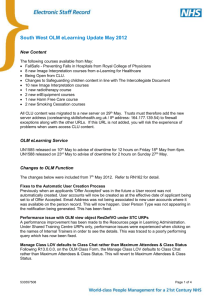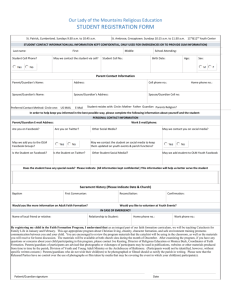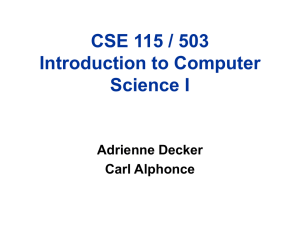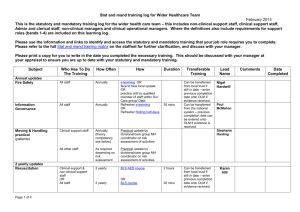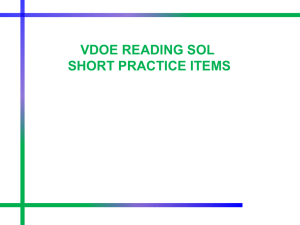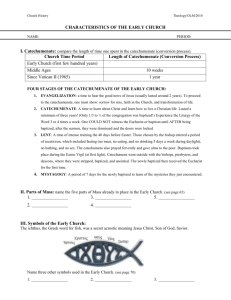A Unified Approach to Modeling and Programming Ole Lehrmann Madsen Birger Møller-Pedersen
advertisement
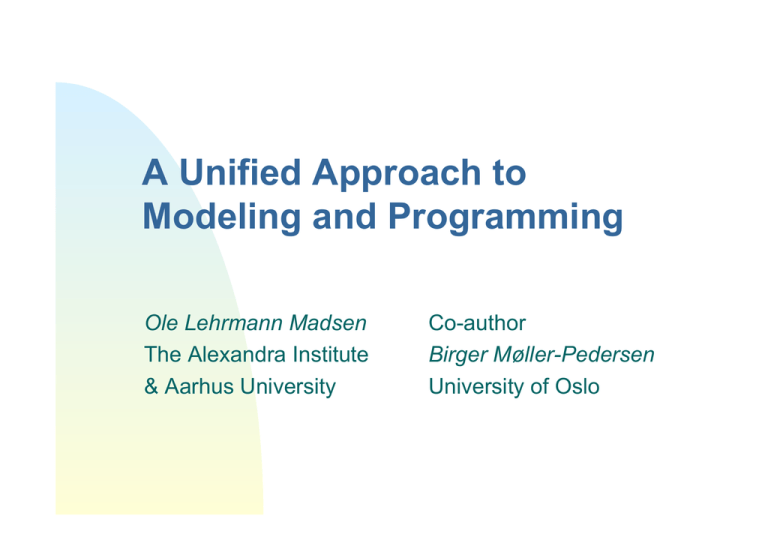
A Unified Approach to
Modeling and Programming
Ole Lehrmann Madsen
The Alexandra Institute
& Aarhus University
Co-author
Birger Møller-Pedersen
University of Oslo
Dahl & Nygaard:
ACM Turing Award Winners
Dahl & Nygaard at the time of Simula’s development
“for their role in the invention of object-oriented
programming, the most widely used programming
model today.” (ACM press release)
Models 2010
olm
2
More than 30 years of collaboration
Kristen Nygaard
Models 2010
Birger Møller-Pedersen
Co-author of
accompanying paper
olm
Bent Bruun Kristensen
3
Contents
Models 2010
SIMULA: back to the future
What is a model?
The conceptual framework of OO
Language issues
olm
4
SIMULA: back to the future
Models 2010
olm
5
OBJECT ORIENTATION: PAST, PRESENT, FUTURE
The Atom:
From Mathematics to Monte Carlo
f(x) = g(x) + λ K(x, y)f(y)dy
Models
2010
KRISTEN
NYGAARD
© Kristen Nygaard, 2000
olm
6
6
OBJECT ORIENTATION: PAST, PRESENT, FUTURE
The SIMULA I language report from 1965
opens with these sentences:
“The two main objects of the SIMULA
language are:
To provide a language for a precise and
standardised description of a wide class of
phenomena, belonging to what we may call
“discrete event systems”.
To provide a programming language for an
easy generation of simulation programs for
“discrete event systems”.”
Models
2010
KRISTEN
NYGAARD
© Kristen Nygaard, 2000
olm
7
7
SIMULA I opening sentences (98-08-11)
OBJECT ORIENTATION: PAST, PRESENT, FUTURE
The past
Models
2010
KRISTEN
NYGAARD
© Kristen Nygaard, 2000
olm
8
8
OBJECT ORIENTATION: PAST, PRESENT, FUTURE
SIMULA I
was a simulation programming language
that turned out to become
a powerful general programming language.
SIMULA 67
is a general programming language
that also is a powerful platform
for other, specialised programming languages,
as e.g. simulation languages.
Models
2010
KRISTEN
NYGAARD
© Kristen Nygaard, 2000
olm
9
9
SIMULA I and SIMULA 67
OBJECT ORIENTATION: PAST, PRESENT, FUTURE
SIMULA 67 was triggered off by
the invention of inheritance in January 1967.
Vehicle
Car
Truck
Bus
Ambulance
Virtual properties
Models
2010
KRISTEN
NYGAARD
© Kristen Nygaard, 2000
olm
10
10
The contributions of Simula .
Object
Class
Subclass – single inheritance
Virtual procedure (method)
Nested/inner classes/procedures
Action combination
inner
Models 2010
olm
11
The contributions of Simula ..
Active objects
Quasiparrallel
systems
Coroutines
Processes and schedulers
Used
for defining process scheduling in
class Simulation
Later extended to concurrency
Necessary to be able to control scheduling
Models 2010
Concurrency abstractions
olm
12
The contributions of Simula ...
The first examples of application
frameworks
Class
Simulation
A domain specific language with special
syntax
Automatic memory management
Garbage
Models 2010
collection
olm
13
Some lessons from SIMULA
SIMULA was created as a means for making
simulation models – motivated by operations
research
SIMULA was a general purpose programming
language
SIMULA was used for implementation and
analysis and design
The application domain was reflected in the
programs
No need for structured analysis and structured
design
Models 2010
SIMULA was a programming language with a built-in
method
olm
14
The BETA language
For modeling and programming
Bent Bruun Kristensen, Ole Lehrmann
Madsen, Birger Møller-Pedersen, Kristen
Nygaard
Generalized abstraction mechanisms
Pattern,
Models 2010
virtual class, etc.
Concurrency, alternation, etc.
An associated conceptual framework
History of Programming Languages III,
San Diego 2007
olm
15
Benefits of object-orientation
Unifying perspective on most phases of
the software life cycle
Programs reflect reality (the application
domain) in a natural way
Good support for programming
Models 2010
Common conceptual framework
Good support for modeling
Common language core:
class, subclass, virtual, method, etc.
Extensibility & reuse
olm
16
The situation today
Divergence of modeling and programming
Object-oriented programming:
Very
Mainstream modeling:
Is
little attention to modeling
widening the gap to programming
Executable models:
The
right direction
A long way to go
Models 2010
olm
17
OBJECT ORIENTATION: PAST, PRESENT, FUTURE
The first duty of a programmer
"The first duty of a revolutionary
is to get away with it."
Abbie Hoffmann
"The first duty of a programmer
is to get away with it."
Hackers' Credo
To program is to understand
Kristen Nygaard
Models
2010
KRISTEN
NYGAARD
© Kristen Nygaard, 2000
olm
18
18
While programmers don’t use
UML
Large and incomprehensible
All you need is code (Nierstrasz)
The
code is the real thing
“Very few real-world objects in my application”
When time becomes critical,
the model is dropped
Difficult
to keep the model consistent with the
code
Impedance mismatch,
as with OOA and OOD
Models 2010
olm
19
The model should be the code
“There similarly appears to be something
fundamentally wrong with model-driven
development as it is usually understood —
instead of generating code from models,
the model should be the code.”
Oscar Nierstrasz:
Ten things I hate about object-oriented programming
Banquet speech, ECOOP 2010
Models 2010
olm
20
What is a model?
Models 2010
olm
21
Is a UML diagram a model?
Models 2010
olm
22
Classes drive me crazy ...
“There is a complete disconnect in OOP between the source
code and the runtime entities. Our tools don’t help us
because our IDEs show us classes, not objects.
I think that’s probably why Smalltalkers like to program in the
debugger. The debugger lets us get our hands on the
running objects and program them directly.
Here is my message for tool designers: please give us an
IDE that shows us objects instead of classes!”
Oscar Nierstrasz:
Ten things I hate about object-oriented programming
Banquet speech, ECOOP 2010
Models 2010
olm
23
The use of modeling
Used in many disciplines:
Science,
engineering, architecture,
entertainment, software development, ...
Models 2010
For communication of properties of
systems
For understanding properties of existing
systems
For analyzing properties before building
new systems
As toys
olm
24
Primitive societies
Models are sometimes believed
to be useful in their own right
Models 2010
Manipulation of the model might
itself cause corresponding
changes in the real world
Sticking pins into wax models of
enemies …
Example due to Tony Hoare
olm
25
Simulation metaphor
Models 2010
SIMULA describes real systems and
generated a simulation
The simulation is the dynamic structure of
objects evolving during execution of the
program
The simulation (program execution)
is considered to be the model
Alan Kay has described object-oriented
programming as a view on computation
as simulation
olm
26
Webster:
Models 2010
A model refers to a small,
abstract or actual representation of a
planned or existing entity or system
from a particular viewpoint.
olm
27
Abstract or actual
Abstract:
mathematical
description
Newton's laws
of motion
Models 2010
Actual:
something physical
A molecule:
olm
28
Planned or existing system
Model of planned
building
Models 2010
Model of (existing)
solar system
olm
29
From a particular viewpoint
A good map provides the information we need for
a particular purpose – or the information the
mapmaker wants us to have
Peter Turchi:
Maps of the Imagination – the writer as a cartographer
Models 2010
olm
30
Description versus model
Description:
Model:
The (physical) material:
Models 2010
olm
31
Object-oriented programming
A program execution is regarded as a
physical model
simulating the behavior of a
real or imaginary system
Models 2010
olm
32
Description versus model
The languages for making descriptions are
important
More attention to the model
Objects,
We need tools showing the program
execution
More
Models 2010
their properties, and actions
than debuggers
The semantics of the language
olm
33
Conceptual framework
Models 2010
olm
34
The basis for modeling
We must understand and develop the
conceptual means for understanding and
organizing knowledge
Guidelines for identifying
Objects,
properties of objects, classes,
class hierarchies, methods, activities
(tasks), …
Models 2010
For understanding the limitations of
programming languages
The theory and semantics of OO
olm
35
Current situation of modeling
Models 2010
Mainstream programming languages:
Modeling was never considered seriously
In Smalltalk many classes are not
substitutable
Subclassing: inheritance of code
Multiple inheritance: often complicated
technicalities
Languages with both types and classes
olm
36
Status of conceptual framework
SIMULA
Modeling
central, but conceptual framework
was implicit
BETA:
The
conceptual framework was developed
together with the language
Test: programming and modeling
Modeling languages:
I
am sure that conceptual framework is
considered important
Models 2010
olm
37
Abstraction
In the development of our understanding
of complex phenomena, the most
powerful tool available to the human
intellect is abstraction
(Tony Hoare, Notes on Data Structuring.
In Dahl, Dijkstra, Hoare:
Structured Programming,
Academic Press, 1972)
Models 2010
Identification of phenomena and
their properties
Formation of concepts
olm
38
Conceptual means
Identification of objects
Classification
Clustering
Generalization/specialization
Composition/aggregation
Whole/part
Reference
composition
Concept composition
Models 2010
Association
olm
39
Class and concept
A concept is represented as a class
Intension: attributes and methods
Extension: the instances of the class
Referent system
Model system
Concept: Person, ...
Class: Person, ...
Phenomena: Churchill, ...
Object: Churchill, ...
Models 2010
olm
40
Concept hierarchies
Subclass
The extension of Car is a subset of the extension of Vehicle
Extends
The intension of Car extends the intension of Vehicle
Vehicle
Car
Truck
c1 c2 c3
t1 t2 t3
Models 2010
Bus
b1 b2 b3
olm
41
Tree structured classification
Subclasses with disjoint extensions
Vehicle
Car
Truck
c1 c2 c3
t1 t2 t3
Models 2010
Bus
b1 b2 b3
olm
42
Non-tree structured classification
Subclasses with overlapping extensions
Parallelogram
Rectangle
Rhomb
Square
re1 re2 re3
Models 2010
sq1 sq2 qs3
olm
rh1 rh2 rh3
43
Several classification hierarchies
Independent tree-structured
classifications of the same objects
Profession
Nurse
Nationality
Models 2010
European
...
American
...
Asian
Teacher
p1
p2
p3
p4
p5
p6
...
...
...
olm
44
Dynamic classification
Objects may change class
membership during their existence
Profession
student
programmer
manager
LizaLarsen
time t1
LizaLarsen
time t2
LizaLarsen
time t3
Models 2010
olm
45
Behavior hierarchies
Part/whole composition
Generalization/specialization
Travel
Movement
Travel
Jump
Source
Run
Destination
Duration
Vehicle
Clustering
Travel
Columbus's
America-expedition
Models 2010
Hannibal's march
across the Alps
olm
46
Design patterns:
a challenge for abstraction
myDesignPattern:
X
Z
Y
Program
fragment 1
Models 2010
A
Program
fragment 2
olm
Program
fragment 3
47
Abstraction mechanisms
The conceptual framework shows
limitations of current abstraction
mechanisms:
Class,
Models 2010
type, virtual, procedure, generic, etc.
We should derive new abstraction
mechanisms
olm
48
Properties of phenomena in
information systems
Models 2010
Physical material
Properties of material
Actions
olm
49
Language issues
Models 2010
olm
50
Issues
Models 2010
Syntax
Constraints
Domain specific
languages
Scenario
descriptions
Programming by
examples
olm
State machines
Associations
Asynchronous
events
Action sequences
Other constructs
51
Diagrams and code: different views
Record: { … };
Record
Person: Record { … }
Person
Book
Student: Person{ … }
Employee: Person{ … }
Student
Employee
Book: Record{ … }
Common
Representation
Models 2010
Abstract
syntax
tree
olm
• One to one
correspondence
• No code
generation
52
A picture says more than a thousand words
A word says more than a thousand
pictures:
Vehicle:
Models 2010
olm
53
Constraints
Models 2010
Class invariants,
Pre- and post- conditions
Assertions
Constraint-oriented programming
Useful for programming as well
Modeling/specification work could drive
this
olm
54
Scenario descriptions
Models 2010
Emphasis on run-time – the model
UML sequence diagrams, object diagrams,
etc., are steps in the right direction
Should be a part of any programming
language definition
We need a notation for the whole program
execution
olm
55
Programming by examples
Models 2010
Derive descriptions / programs from
scenarios / examples
From interaction diagrams to
state-machines
Derivation of programs from examples
olm
56
State-machines & associations
The justifying examples for modeling
languages
Issues:
Precise
semantics?
Programming language abstraction
mechanisms
Design patterns
Textual or graphical notation
Embedding of graphical language
Models 2010
olm
57
Asynchronous events and actions
Relevant for programming as well as
modeling
Sequential actions
The
Concurrency
We
Models 2010
same for programming and modeling
need better concurrency abstractions
olm
58
Concurrency
Modeling of concurrent processes from the
real world was essential for SIMULA
SIMULA had quasi-parallel processes
Major difference between modeling
languages and programming languages
Challenge:
Strong
need for better mechanisms for
modeling and implementing concurrent
processes
Models 2010
olm
59
Executable modeling language
Models 2010
Must subsume state-of-art from
programming languages
Must be just as efficient as programming
languages
No need for modifying the generated code
Just a new higher level programming
language
A long way to go
olm
60
Summary
Models 2010
olm
61
A unified approach
Language for modeling and programming
Executable
Non-executable
Model: program execution
Properties,
Models 2010
notation, tools
Conceptual framework
olm
62
Back to the future
SIMULA:
the strength of a unified approach to
modeling and programming is fading away
Re-unite the forces
Don’t
let programmers get away with it
Don’t let modelers just create bubbles
Models 2010
olm
63
